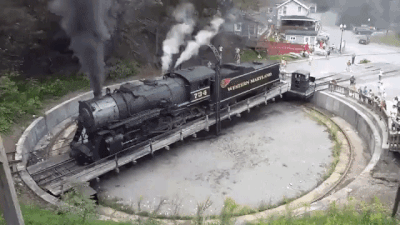
Steam Locomotives
Locomotives are one of the most important machines in the history of the world.
Barton rode trains propelled by coal-fired steam.
Back in the 1990s, I completed two ‘Stationary Engineering’ courses at my local community college.
This taught me how steam-power is created and used, in standing-still boilers, to create steam power.
Steam boilers heat buildings, cook food in food factories and generate electricity.
Much of the electricity used to charge electric cars, is made by coal-fired steam power-plants that generate electricity.
Decades ago, steam-engines also propelled paddles-ships, like sidewheelers. More of America could then be explored and settled, because paddlewheelers could go upstream. This really was a big deal to the growth of America.
And steam engines also had other uses, like powering belt-driven machinery in factories, before factories had electrical machinery. Many early farm tractors were steam machines, not combustion-engine powered.
And I've even ridden a steam-powered merry-go-round at ‘Pioneer Village’ in Minden, Nebraska.
Pioneer Village also has a real display locomotive on site.
Steam engines have two basic drive systems that create power.
The first is the 'vane-on-shaft' drive system, which you can look up.
Many steam locomotives used the piston/valve drive system, which you can see at,
https://www.youtube.com/watch?v=b7NABUkyGok
This is the same family of engines used by paddlewheel steamboats, but powered by 'scotch boilers'.
It is fascinating, complicated machinery which required a lot of math to design. Inventors need to know math,
or know someone who knows how to do math.
Locomotives are unique machines.
They run on tracks, and are steered by the tracks. Designers borrowed this system from early horse-drawn trolley cars.
But they haul larger loads, farther and faster that horses can.
Trains are labeled by how many wheels they have.
If you see a train labeled as a 2-8-2, It means that the locomotive has:
One pair of PILOT WHEELS (2), up front, which follow the track.
It has 4 pairs of DRIVING WHEELS (8 big wheels), propelled by the steam made in the locomotive’s boiler.
It has 1 pair TRAILING WHEELS (2), which support the back part of the locomotive.
And we can asssume that the power of the locomotive match the number of driving wheels.
The size of the locomotive and the number of wheels were dictated by what the train hauled, the terrain the locomotive worked, and the condition of the tracks on each route. Trains tended to stay in a particular route, like our mail carriers.
So each type of locomotive had a place where it worked better than other styles of locomotives.
There was a locomotive made just for shuffling cars around the railyard. It was often a 0-4-0. Look it up; it’s a short critter. Remember the locomotive in the Dallas County Mystery?
Trains on the plains could run faster than trains that ran through tight, curvy mountains.
One locomotive, the Union Pacific ‘Big Boy', is a long, (132’) articulated locomotive, a 4-8-8-4.
Its boiler sits on a pivoting frame to help it steer on curving tracks. It has:
4 Pilot wheels
8 Drivers
Another 8 Drivers
4 Trailing wheels.
It weighs about 1.2 million pounds. Big. Look it up.
Big Boy has the power to pull, on level ground, a line of freight cars over 5 miles long. Wow.
And it can run 70 miles per hour.
But most train gangs pull up to 100 cars; just over one mile long. Trains often take over a mile to stop.
This is why you don’t want to go around railroad crossing gates.
Wait for the train to pass, whether you be on foot, in a car, or on a bike.
The picture above is a train on a turntable, which is how they turn trains.
When the train reaches the end of its run, it needs to head back the other way, on a different day, always with a different load.
Can you spot the man with the machine that turns the train? Look closely.
Steam power was a part of STEM from the 1600s, when it was first used in pulling water from underground mines that tended to fill with water. Funny how water was harnessed in one way, to move different water, eh?
Eric J. Rose
middlegrademysteries.com
Photo, gif: pinterest